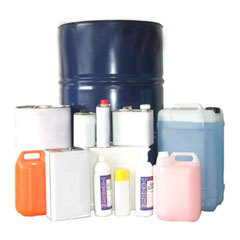 This is kinda techie but interesting if you’re digging deep in to repurposed plastics. I discovered a post on what solvents work with specific plastics. Pure nail polish remover (Acetone) works with most plastics. The process of solvent welding is simple. You apply the solvent to the pieces you want to stick together, push the pieces together and then wait for the solvent to evaporate and the plastic to solidify. The most difficult part is thus finding solvents that will dissolve the plastic in question. The post answers these questions.
This is kinda techie but interesting if you’re digging deep in to repurposed plastics. I discovered a post on what solvents work with specific plastics. Pure nail polish remover (Acetone) works with most plastics. The process of solvent welding is simple. You apply the solvent to the pieces you want to stick together, push the pieces together and then wait for the solvent to evaporate and the plastic to solidify. The most difficult part is thus finding solvents that will dissolve the plastic in question. The post answers these questions.
Below are the interesting parts and the full post and comments can be found here
Safety Warning: most of these solvents are toxic. Do not inhale them, especially deliberately. Use in a very well ventilated area. They are also highly volatile and thus flammable. Keep away from open flames. Do not smoke while applying solvents.
On solubility
The following is an incomplete list of the most common plastics used in Nerf and their compatibility with common solvents. A “Y” indicates that the solvent will dissolve the plastic in question. A “N” indicates that the solvent is not recommended for use with that plastic. Either it does not dissolve the plastic at all or does so poorly. At the end of this post is a listing of the solvents.
Polymethyl methacrylate (Acrylic)
– 1,2 Dichloroethane: Y
– Acetone: Y
– Cyclohexanone: Y
– Dichloromethane: Y
– MEK: Y
– Methyl benzene: Y
– Tetrahydrofuran: Y
Acrylonitrile butadiene styrene (ABS)
– 1,2 Dichloroethane: Y
– Acetone: Y
– Cyclohexanone: Y
– Dichloromethane: N
– MEK: Y
– Methyl benzene: N
– Tetrahydrofuran: N
Polyacetal (Delrin – POM)
– 1,2 Dichloroethane: N
– Acetone: N
– Cyclohexanone: N
– Dichloromethane: N
– MEK: Y
– Methyl benzene: Y
– Tetrahydrofuran: N
Cellulose acetate butyrate (Butyrate)
– 1,2 Dichloroethane: Y
– Acetone: Y
– Cyclohexanone: Y
– Dichloromethane: Y
– MEK: Y
– Methyl benzene: Y
– Tetrahydrofuran: Y
Cross-linked low density polyethylene (PEX)
– 1,2 Dichloroethane: Y
– Acetone: Y (at 100%)
– Cyclohexanone: N
– Dichloromethane: Y
– MEK: N
– Methyl benzene: Y
– Tetrahydrofuran: Y
Low density polyethylene (LDPE)
– 1,2 Dichloroethane: Y
– Acetone: Y
– Cyclohexanone: Y
– Dichloromethane: Y
– MEK: Y
– Methyl benzene: N
– Tetrahydrofuran: N
High density polyethylene (HDPE)
– 1,2 Dichloroethane: Y
– Acetone: Y
– Cyclohexanone: N
– Dichloromethane: N
– MEK: Y
– Methyl benzene: Y
– Tetrahydrofuran: N
Ultra high molecular weight polyethylene (UHMW)
– 1,2 Dichloroethane: N
– Acetone: N
– Cyclohexanone: N
– Dichloromethane: Y
– MEK: N
– Methyl benzene: Y
– Tetrahydrofuran: N
Nylon
– 1,2 Dichloroethane: N
– Acetone: N
– Cyclohexanone: N
– Dichloromethane: N
– MEK: N
– Methyl benzene: N
– Tetrahydrofuran: N
Polycarbonate
– 1,2 Dichloroethane: Y
– Acetone: Y
– Cyclohexanone: Y
– Dichloromethane: Y
– MEK: Y
– Methyl benzene: Y
– Tetrahydrofuran: Y
Polyester (Polyethylene terephthalate – PET)
– 1,2 Dichloroethane: Y
– Acetone: Y
– Cyclohexanone: N
– Dichloromethane: Y
– MEK: N
– Methyl benzene: N
– Tetrahydrofuran: Y
Copolyester (Polyethylene terephthalate glycol – PETG)
– 1,2 Dichloroethane: Y
– Acetone: Y
– Cyclohexanone: Y
– Dichloromethane: Y
– MEK: Y
– Methyl benzene: Y
– Tetrahydrofuran: Y
Polypropylene
– 1,2 Dichloroethane: Y
– Acetone: Y
– Cyclohexanone: N
– Dichloromethane: Y
– MEK: N
– Methyl benzene: Y
– Tetrahydrofuran: N
Polystyrene
– 1,2 Dichloroethane: Y
– Acetone: Y
– Cyclohexanone: Y
– Dichloromethane: Y
– MEK: Y
– Methyl benzene: Y
– Tetrahydrofuran: Y
Polyvinyl chloride (PVC)*
– 1,2 Dichloroethane: Y
– Acetone: Y
– Cyclohexanone: Y
– Dichloromethane: Y
– MEK: Y
– Methyl benzene: Y
– Tetrahydrofuran: Y
*Includes PVC in pipe and flexible tube, as well as CPVC as we use it, since our CPVC is simply Copper-sized PVC and not Chlorinated PVC.
Teflon (TFE)
– 1,2 Dichloroethane: N
– Acetone: N
– Cyclohexanone: N
– Dichloromethane: N
– MEK: N
– Methyl benzene: N
– Tetrahydrofuran: N
On solvents
1,2 Dichloroethane: Also known as Ethylene dichloride. Found in paint removers.
Acetone: Found in small quantities in nail polish remover. Also found in various plastic cements. Also found in acrylic paint thinners and varnishes. Can be bought pure.
Cyclohexanone: Found in plastic cement, particularly ABS and PVC pipe cement.
Dichloromethane: Also known as Methylene chloride. Found primarily in paint stripper. Used as an industrial solvent. Banned in Europe.
Methyl ethyl ketone (MEK): Also known as Butanone. A large component of almost all plastic cements especially ABS and polystyrene cement. Can be bought pure.
Methyl benzene: Also known as Toluene. Used mostly as a paint thinner or paint remover. Found along with MEK in polystyrene model kit cement.
Tetrahydrofuran: Found almost exclusively in PVC cement. Can also be in some varnishes.
Plastic cement is generally comprised of a solvent (or mixture of solvents) along with dissolve plastic resin of the plastic in question. Thus PVC cement will contain dissolved PVC along with the solvents.
Examples:
Genova ABS cement is around 20% Acetone, 60% MEK, and 20% ABS resin.
Oatey Green Transition cement is around 40% Tetrahydrofuran, 35% Acetone and MEK, 10% Cyclohexanone, and 15% PVC resin. Look either on the can or search for Material Safety Data Sheets for the ingredients and quantities, and then look up which plastics these will work with.

